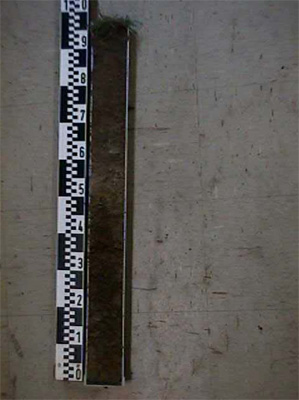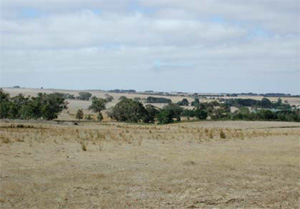BD12
|
| BD12 |  Melanic, Subnatric, Brown Sodosol | |
| Elaine | |||
| Gently undulating plain | |||
| Quaternary basalt | |||
| Hillslope | |||
| 4–7% | |||
Horizon | Depth (cm) | Description | ||
A1 | 0–38 | Dark brown (7.5YR3/2); sandy loam; strong structure; friable; pH 6.0; sharp boundary to: | ||
A2 | 38–50 | Pale brown (10YR6/3); sandy clay loam; moderate structure; friable; pH 6.5; sharp boundary to: | ||
B2 | 50–100+ | Yellowish brown (10YR5/4) with few red mottles; medium to heavy clay; weak structure; pH 7.5. | ||
| Management considerations | ||||
The grey basaltic loam is suited to growing pastures, but can be used quite successfully for growing cereal crops, oilseed and peas, especially in the drier areas or in dry seasons in the wetter areas. Summer fodder crops grow very well because of the good moisture retention of this soil. Autumn growth on the grey soil is slow and winter growth poor (compared with red or sandy soils), but spring growth is excellent and continues later into the spring than on the red or sandy soils. Potatoes can be grown satisfactorily, especially with irrigation, but must be dug in autumn to avoid winter waterlogging. In some situations (the drier ‘banks’) lucerne will survive and grow well, but usually this grey soil becomes too wet in winter for lucerne. | ||||
Analytical data
Site BD12 | Sample depth | pH | EC | NaCl | Ex Ca | Ex Mg | Ex K | Ex Na | Ex Al | Ex Acidity | FC –10kPa | PWP –1500kPa | KS | FS | Z | C | |
Horizon | cm | H2O | CaCl2 | dS/m | % | cmolc/kg | cmolc/kg | cmolc/kg | cmolc/kg | mg/kg | cmolc/kg | % | % | % | % | % | % |
A1 | 0–10 | 5.9 | 4.7 | <0.05 | N/R | 1.2 | 2.0 | 0.1 | 0.34 | 26 | N/R | N/R | N/R | N/R | N/R | N/R | N/R |



